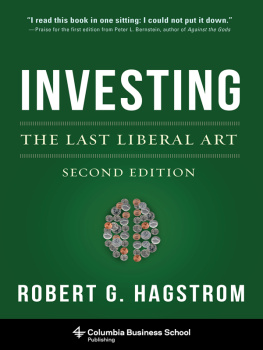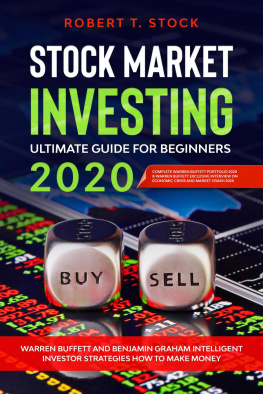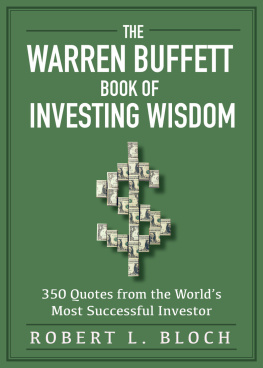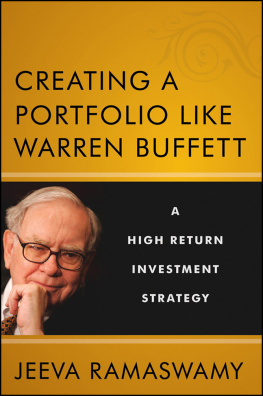INVESTING: THE LAST LIBERAL ART
INVESTING

THE LAST LIBERAL ART

SECOND EDITION
ROBERT G. HAGSTROM
 | Columbia Business School
Publishing |
Columbia University Press
Publishers Since 1893
New York Chichester, West Sussex
cup.columbia.edu
Copyright 2013 Robert G. Hagstrom
All rights reserved
E-ISBN 978-0-231-53101-6
Library of Congress Cataloging-in-Publication Data
Hagstrom, Robert G., 1956
Investing : the last liberal art / Robert G. Hagstrom.2nd ed.
p. cm.
Includes bibliographical references and index.
ISBN 978-0-231-16010-0 (cloth : alk. paper)
ISBN 978-0-231-53101-6 (ebook)
1. Investments. I. Title.
HG4521.H2263 2012
332.6dc23 2012036489
A Columbia University Press E-book.
CUP would be pleased to hear about your reading experience with this e-book at .
Cover design: Noah Arlow
References to Internet Web sites (URLs) were accurate at the time of writing. Neither the author nor Columbia University Press is responsible for URLs that may have expired or changed since the manuscript was prepared.
CONTENTS
In 2000, I wrote a book then titled Latticework: The New Investing. It was a liberal arts interpretation of investing, inspired by Charlie Mungers lectures on the art of achieving what he called worldly wisdom. For those who dont know Charlie, he is vice-chairman of Berkshire Hathaway and investment partner to Warren Buffett, who is, arguably, the worlds greatest investor.
Latticeworkthe titlewas deliberately chosen to make clear its linkage to Charlies approach. His concept of a latticework of mental models is well known to investors and instantly identifiable. Or so I thought. I have since learned that authors are best at writing books but marketing professionals are best at titling and publicizing them. In the year following the publication of Latticework, the publisher decided to relaunch the book as a paperback with a new titleInvesting: The Last Liberal Art. Result? A definite spike in interest in the book. Then, when Columbia University Press asked if I would be interested in revisiting the original work with a second edition, I immediately accepted the opportunity. One, because I deeply believe in the values and lessons of the book but more importantly, because of the amount of new knowledge (new to me, at least) that I have gained over the past decade. For one small example, there are about one hundred new entries in the Bibliography.
The overall structure of the book is the same. We take a look at the major mental models in physics, biology, sociology, psychology, philosophy, and literature. To that we have added an entirely new chapter on mathematics. The book then concludes with a chapter on decision making. For those who have read the first edition, you will revisit many of the classical models, but you will also receive substantially new knowledge and understanding based on new material in each chapterproof positive that learning is a continuous process.
Keep one thing firmly in mind: this is not a how-to book on investing. You wont find a new set of step-by-step instructions on how to pick stocks or manage your portfolio. However, after reading this book, what you will have, if you are willing to spend some time with challenging ideas, is a new way to think about investing and a clearer understanding of how markets and economies work. It is an understanding derived not from the economics and finance textbooks, but from the basic truths embedded in a number of seemingly unrelated disciplines, the same disciplines you would find in a classical liberal arts education.
To develop this new understanding, you and I will walk together through those areas of knowledge, investigating the basic and fundamental concepts in each field. Sometimes we will begin with a historical overview to see how the concepts originated and then move forward; always we shall examine how those concepts relate to investing and the markets. One chapter at a time, one piece at a time, with some of the greatest minds of all time, we shall assemble a new and original way to think about investing.
I must confess that writing this book was difficult. It required delving deeply into several disciplines and then distilling the essence of each into one short chapter. The discussions are, of necessity and without undue apology, both brief and general. If you happen to be an expert in any one of these disciplines, you may quibble with my presentation or may conclude I have omitted certain concepts. However, I hope you appreciate that to do otherwise would have resulted in a book with chapters one hundred pages long and a final manuscript equal in proportion to an encyclopedia. While writing this book, I came to believe it was far more important to deliver an abbreviated sermon to a larger number of people than to restrict its overall message to the few who would be willing to tackle a dissertation. For this reason, I hope you will recognize it was necessary to limit the descriptions in each discipline to the very basics.
Even so, many readers may find that reading this book is something of a challenge, no less than the writing was for me. It was challenging on two levels. First, some of the chapters may deal with disciplines that are unfamiliar to you, and reading them may remind you of an intensive college-level seminar. Nonetheless, it is my hope that you will find the exposure to new ideas stimulating and rewarding. Second, because each chapter presents a completely different field of study, the total benefit of the book may not be fully clear until you reach the end. It is a cumulative process, with each chapter adding a new layer of ideas. I have tried to point out common themes and mental links, but my comments are no substitute for your own personal revelation that will come from careful study and thoughtful reflection.
Reading this book requires, then, both an intellectual curiosity and a significant measure of patience. In a world that increasingly seeks to solve our needs in the shortest amount of time, this book may be an anomaly. However, I have always believed there are no shortcuts to greater understanding. You simply have to work through the basics.
This broad-based approach to understanding is the heart of a liberal arts approach to investing. It is no longer enough to just acquire and master the basics in accounting, economics, and finance. To generate good investment returns, I believe, requires much more. It is driven by a keen mental appetite to discover and use new insights regardless of what Dewey decimal number they bear or how unrelated they may at first appear.
Mistakes in investing most often occur because of investor confusion. In my opinion, the basic investment lessons we have learned thus far have not given us a complete view of how markets work or how investors operate within markets. No wonder were confused. No wonder we make mistakes. When we dont understand something, there is always a fifty-fifty chance we will make the wrong decision. If this book improves, even slightly, your understanding of investing and how markets work, then the odds of success will tilt in your favor.
Robert G. Hagstrom
Villanova, Pennsylvania
September 2012
In April 1994, at the Marshall School of Business of the University of Southern California (USC), students in Dr. Guilford Babcocks Student Investment Seminar got a rare treat: a powerful dose of real-world knowledge from a man whose thoughts on money are widely considered priceless.
Next page








